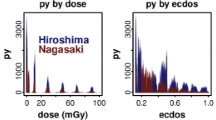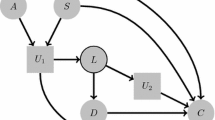Abstract
An earlier analysis examined the possibility of bias in the Life Span Study (LSS) cohort by studying Japanese A-bomb survivors with bomb-related acute injuries and those without such injuries (Stewart and Kneale in Int J Epidemiol 29:708–714, 2000). The authors reported significantly higher radiation risks, both for cancers and non-cancers, among those survivors with acute injuries compared with those without. The risks were reported to be particularly large among survivors aged <10 or ≥55 years of age at the time of bombings. The aim of this paper is to examine these findings more closely using the LSS acute effects data. All the analyses were carried out using Poisson regression. Relative risk models were fitted with adjustment for sex and other factors. Significant differences in relative risk between survivors with epilation and burns and those without epilation and burns are found for leukaemia. There is also some evidence for heterogeneity in the leukaemia risk between survivors with two or more acute injuries and those with no injuries, but the evidence is disappeared when survivors with one or more injuries are compared with those without injuries. For solid cancers, cardiovascular disease and all deaths combined, the risks do not differ to a statistically significant extent between survivors with and without injuries. There is no statistically significant heterogeneity in risk across age-at-exposure categories for survivors with injuries. For all deaths combined, relative risk estimates and their uncertainties are significantly higher for survivors exposed at ages <10 years when compared with other exposure ages, but risks are not significantly raised for survivors exposed at ≥55 years of age. With the exception of leukaemia, the findings from the present work are inconsistent with those of Stewart and Kneale.
Similar content being viewed by others
References
Pierce DA, Preston DL (2000) Radiation-related cancer risks at low doses among atomic bomb survivors. Radiat Res 154:178–186
Preston DL, Kusumi S, Tomonaga M, Izumi S, Ron E, Kuramoto A, Kamada N, Dohy H, Matsui T, Nonaka H, Thompson DE, Soda M, Mabuchi K (1994) Cancer incidence in atomic bomb survivors. Part III. Leukemia, lymphoma and multiple myeloma, 1950–1987. Radiat Res 137:S68–S97
Preston DL, Pierce DA, Shimizu Y, Cullings HM, Fujita S, Funamoto S, Kodama K (2004) Effect of recent changes in atomic bomb survivor dosimetry on cancer mortality risk estimates. Radiat Res 162:377–389
Preston DL, Shimizu Y, Pierce DA, Suyama A, Mabuchi K (2003) Studies of mortality of atomic bomb survivors. Report 13: Solid cancer and non-cancer disease mortality: 1950–1997. Radiat Res 160:381–407
Gilbert ES, Ohara JL (1984) An analysis of various aspects of atomic bomb dose estimation at RERF using data on acute radiation symptoms. Radiat Res 100:124–138
Neriishi K, Stram DO, Vaeth M, Mizuno S, Akiba S (199) The observed relationship between the occurrence of acute radiation effects and leukemia mortality among A-bomb survivors. Radiat Res 125:206–213
Stewart AM, Kneale GW (2000) A-bomb survivors: factors that may lead to a re-assessment of the radiation hazard. Int J Epidemiol 29:708–714
Little MP (2002) Absence of evidence for differences in the dose–response for cancer and non-cancer endpoints by acute injury status in the Japanese atomic-bomb survivors. Int J Radiat Biol 78:1001–1010
Shimizu Y, Kato H, Schull WJ, Hoel DG (1992) Studies of the mortality of A-bomb survivors. 9. Mortality, 1950–1985: Part 3. Noncancer mortality based on the revised doses (DS86). Radiat Res 130:249–266
Thompson DE, Mabuchi K, Ron E, Soda M, Tokunaga M, Ochikubo S, Sugimoto S, Ikeda T, Terasaki M, Izumi S, Preston DL (1994) Cancer incidence in atomic bomb survivors, Part II: solid tumours, 1958–1998. Radiat Res 137:S17-S67
Preston DL, Lubin JA, Pierce DA, McConney ME (1993) Epicure user’s guide
UNSCEAR (1994) United Nations Scientific Committee on the Effects of Atomic radiation. Sources and Effects of Ionising radiation. United Nations, New York
UNSCEAR (2000) United Nations Scientific Committee on the Effects of Atomic Radiation. Sources and Effects of Ionising Radiation. United Nations, New York
Pierce DA, Shimizu Y, Preston DL, Vaeth M, Mabuchi K (1996) Studies of the mortality of atomic bomb survivors. Report 12, Part I. Cancer: 1950–1990. Radiat Res 146:1–27
Shimizu Y, Kato H, Schull WJ, Preston DL, Fujita S, Pierce DA (1989) Studies of the mortality of A-bomb survivors. 9. Mortality, 1950–1985: Part 1. Comparison of risk coefficients for site-specific cancer mortality based on the DS86 and T65DR shielded kerma and organ doses. Radiat Res 118:502–524
Stewart AM (1997) A-bomb data: detection of bias in the Life Span Study cohort. Environ Health Perspect 105:1519–1521
Stewart AM, Kneale GW (1999) A-bomb survivors: reassessment of the radiation hazard. Med Confl Surviv 15(1):47–56
Little MP (2001) Comparison of the risks of cancer incidence and mortality following radiation therapy for benign and malignant disease with the cancer risks observed in the Japanese A-bomb survivors. Int J Radiat Biol 77:431–464
Little MP, Hawkins MM, Charles MW and Hilderth NG (1992) Fitting the Armitage_Doll model to radiation-exposed cohorts and implications for population risks. Radiat Res 132: 207–221, and 137:124–128
Little MP (1995) Are two mutations sufficient to cause cancer? Some generalisations of the two-mutation model of carcinogenesis of Moolgavkar, Venzon, and Knudson, and of the multistage model of Armitage and Doll. Biometrics 51:1278–1291
Little MP and Muirhead CR (1997) Curvilinearity in the dose response curve for cancer in Japanese atomic bomb survivors. Environ Health Perspect 105(suppl 6):1505–1509
Pierce DA, Stram DO and Vaeth M (1990) Allowing for random errors in radiation dose estimates for the atomic bomb survivor data. Radiat Res 123:275–284
Acknowledgements
The authors would like to thank Dr Dale Preston (formerly of RERF) and the reviewers for their helpful comments. We wish in particular to thank one of the reviewers for resolving a discrepancy between the data used in this paper and those described by Stewart and Kneale. This report makes use of data obtained from the Radiation Effects Research Foundation (RERF), Hiroshima and Nagasaki, Japan. RERF is a private, non-profit foundation funded by the Japanese Ministry of Health, Labour and Welfare and the U.S. Department of Energy, the latter through the National Academy of Sciences. The conclusions in this report are those of the authors and do not necessarily reflect the scientific judgment of RERF or its funding agencies or of the authors’ employers. The European Commission provided partial funding for this analysis under contract FIGD-CT-2000-0079 (part of Framework Programme 5 of the Euratom Research and Training Programme in the Field of Nuclear Energy (1998–2002))
Author information
Authors and Affiliations
Corresponding author
Rights and permissions
About this article
Cite this article
Hunter, N., Muirhead, C.R. & Zhang, W. Possible selection effects for radiation risk estimates in Japanese A-bomb survivors: reanalysis of acute radiation symptoms data. Radiat Environ Biophys 45, 17–26 (2006). https://doi.org/10.1007/s00411-006-0040-9
Received:
Accepted:
Published:
Issue Date:
DOI: https://doi.org/10.1007/s00411-006-0040-9




